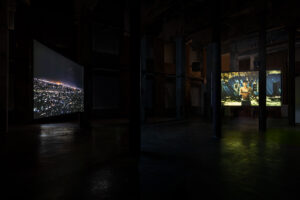Gallery One
تنها صداست که می ماند
Aziz Hazara, It’s Only Sound That Remains examines sound as a powerful repository for memory, recognition, and a source of critical reflection in contemporary Afghanistan. Curated by Muheb Esmat, the exhibition brings together two large-scale video installations by Hazara that highlight the sonic performativity of power and politics in the everyday. Through two distinct acoustic experiences: a mourning ritual, and Kabul’s soundscape during the most recent regime change, the works in this exhibition portray sounds as a formidable agent and medium for personal and social transformation.
In Takbir (2021), a young man slowly beats his chest while maintaining unflinching eye contact with the camera. The actor’s rhythmically repeated action resembles a mourning ritual performed in crowds during Ashura, an annual event that theatrically symbolizes the struggle against injustice. Here Hazara expands on how sound conditions and contours subjectivity. Whereas the sounds of a collective act of mourning validate certain politics, the singular act performed by an individual outside of the polis holds the possibility of presenting a counter-history. Reflected in the embodied sound of flesh beating flesh is a rumination on the body as a site of mortality, vulnerability, and agency. Besides attesting to the physical toll continuous injustice inflicts on the mourning body, Takbir also ponders how to situate the sound of mourning when there is no communal language and consensus for a loss.
Also on view, Takbir (2022) presents a nocturnal panorama of a city on the verge of tectonic change, catalyzed by the ending of the American occupation of Afghanistan and the return of the Taliban, pushing the local subjects into an interminably spectral state. The barking sounds of stray dogs roaming Kabul’s streets at night are sporadically interrupted by the sounds of military aircraft and citizens shouting “Allahu Akbar” (“God is great”) from their rooftops in a proverbial call often deployed at times of distress, joy, and resistance. In this case, it was an outcry against the Taliban’s return, which was quickly co-opted into a campaign for last-minute legitimacy by the outgoing Afghan government. A grainy shot of an American surveillance balloon slowly fades into the horizon, giving way to the Taliban’s distinct sonic regime reverberating through the city. Drawing on these moments as remnants of a longer history, Hazara underscores how power and agency are alternately exercised and stripped through sound and its ability to disintegrate and reconfigure spaces.
The exhibition takes its title from the eponymous book by Asadullah Safi, تنها صداست که می ماند (It’s Only Sound That Remains), memorializing the music produced by Ahmad Zahir (1946-79), one of Afghanistan’s most celebrated pop stars. Zahir’s posthumous fame and undeniable place in public memory are linked to the weight of a social history intertwined with the sounds of his music, bestowing upon his work a cultural significance that lives beyond the span of human life. Hazara’s works expand on this expression to include the possibility of eternality in all sonic constructions, exploring sounds as more than a visceral marker of a given moment and highlighting the urgency for understanding the role of sound within the politics of power.
Aziz Hazara, It’s Only Sound That Remains is part of the newly launched Close Readings series, and is guest-curated by Muheb Esmat in conjunction with the group exhibition Always In My Heart. Close Readings presents a new commission by one under-recognized, early, or mid-career artist in Gallery One, along with an accompanying exhibition in Gallery Two that uses the central commission as a curatorial framework. This program extends our support for interdisciplinary artists by building conversations around their practices in addition to facilitating the realization of ambitious, site-specific projects. This pairing of exhibitions, guest curated by Muheb Esmat, centers the artists’ investigations of the complex and manifold matters of everyday life as experienced in their home countries. It’s Only Sound That Remains and Always In My Heart both explore the root sources and common language available for understanding the contemporary moment in its immeasurable diversity and ever-changing status.
Bios:
Aziz Hazara (b.1992), lives and works between Berlin and Kabul.
Muheb Esmat is an independent curator and writer currently based in New York.
Image:
Left to right: Takbir, 2022, Single-channel digital video, color, sound, TRT 10 min; Takbir, 2021, Single-channel digital video with sound, TRT 5 min.
This exhibition is supported, in part, by public funds from the New York City Department of Cultural Affairs in partnership with the City Council, New York City Council Member Lincoln Restler, and the New York State Council on the Arts with the support of Governor Kathy Hochul and the New York State Legislature, and with generous support from The Andy Warhol Foundation for the Visual Arts, Ruth Foundation for the Arts, Lily Auchincloss Foundation, Robert Lehman Foundation, Select Equity Group Foundation, many individuals and Smack Mellon’s Members.
The exhibition Aziz Hazara, It’s Only Sound That Remains received support from the Barjeel Art Foundation. Research for this exhibition was made possible by the generous support of The Gerda Henkel Foundation.
Smack Mellon’s programs are also made possible with public funds from the National Endowment for the Arts and with generous support from The Edward and Sally Van Lier Fund of The New York Community Trust, Jerome Foundation, The Roy and Niuta Titus Foundation, Milton and Sally Avery Arts Foundation Inc., and Exploring The Arts. In-kind donations are provided by Materials for the Arts, NYC Department of Cultural Affairs/NYC Department of Sanitation/NYC Department of Education.
Space for Smack Mellon’s programs is generously provided by the Walentas family and Two Trees Management.
Smack Mellon would like to extend a special thanks to all of the individuals, foundations, and businesses who have contributed to the NYC COVID-19 Response & Impact Fund.
